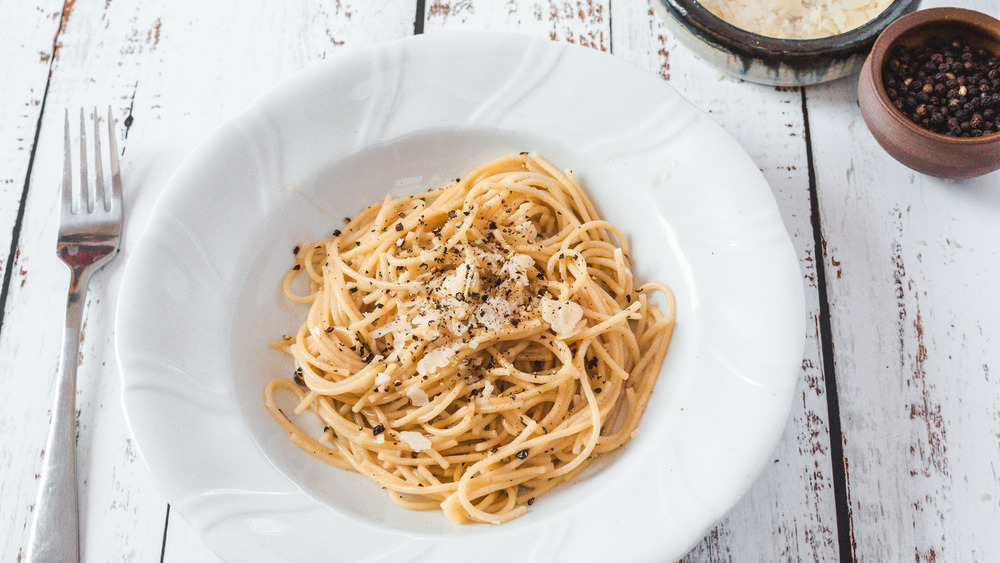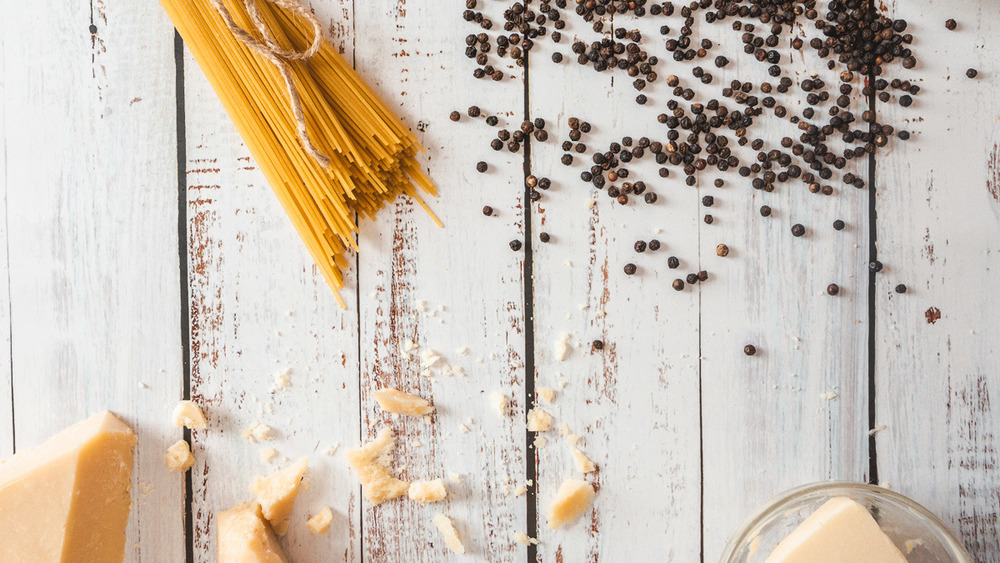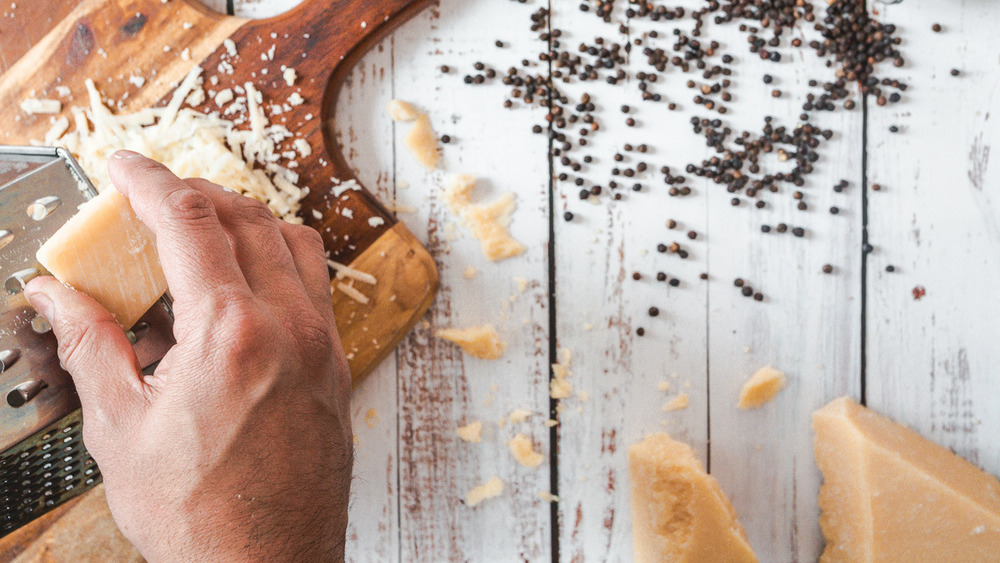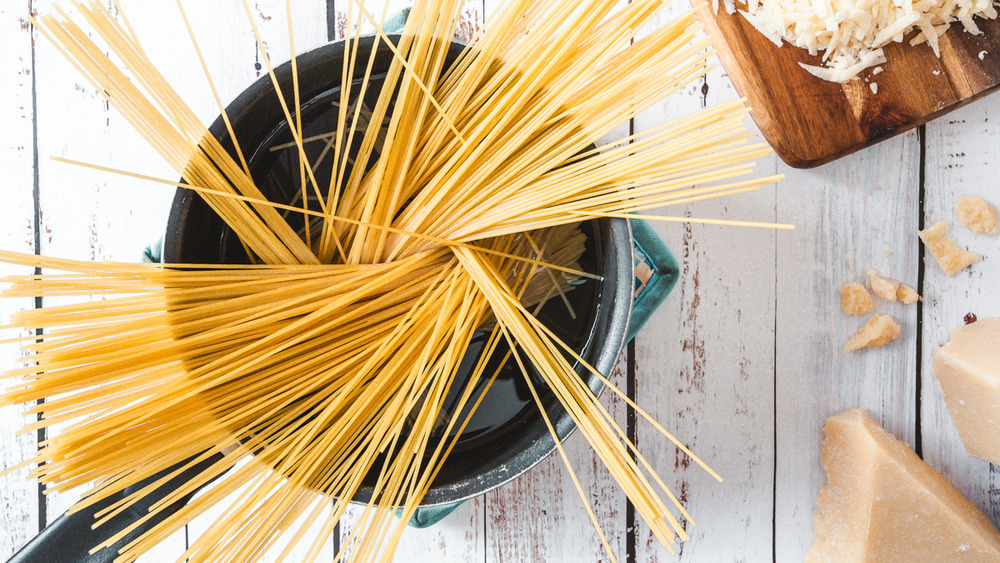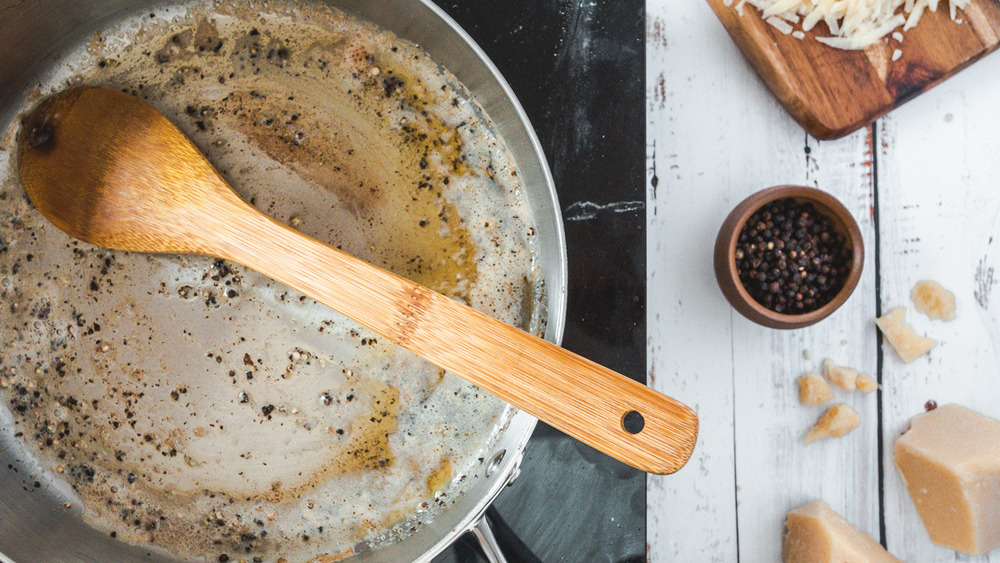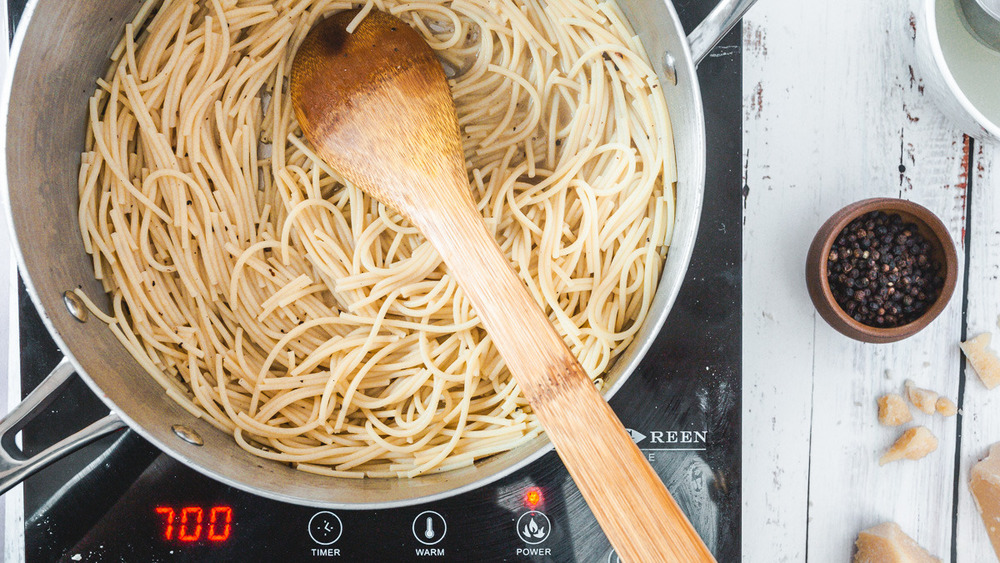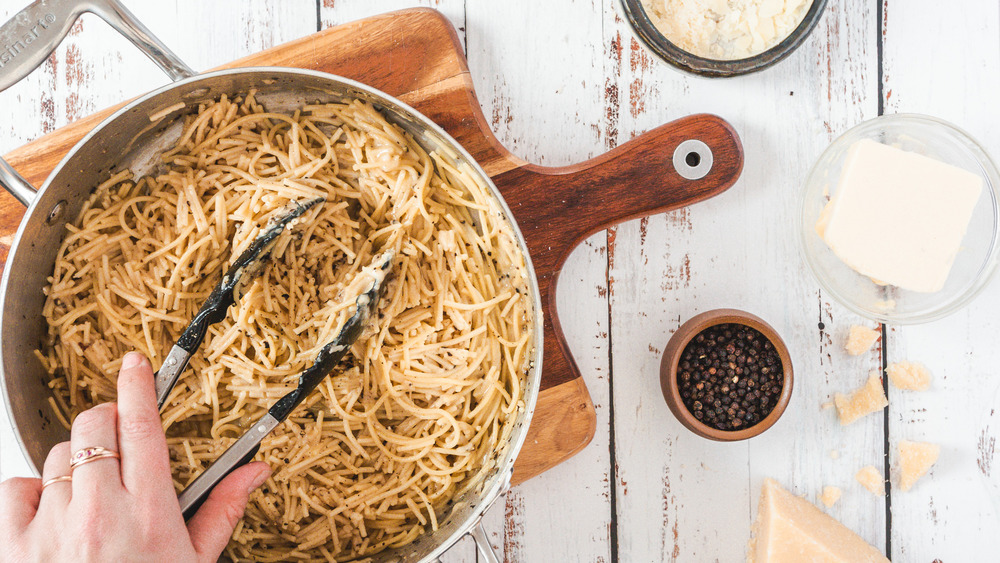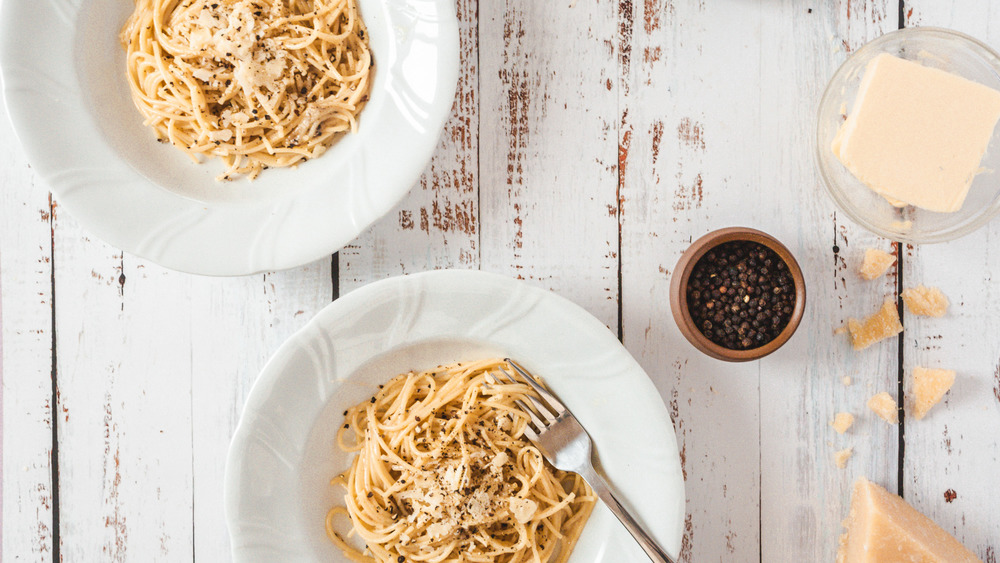Cacio E Pepe Recipe
It's hard to imagine a simpler pasta dish than cacio e pepe. With four ingredients, a 15-minute total cooking time, and the barest of instructions, it's almost offensive to call this a recipe. If pasta is a lazy weeknight meal, then cacio e pepe is easier than ordering on Uber Eats. So why would you bother with it?
Well, if you get those ingredients, and follow our instructions step-by-step, what you will end up with will be a dish so creamy, so perfectly balanced, so magically flavored that you'd be hard-pressed to believe it didn't come from a 100-year-old restaurant in Italy.
Because you shouldn't mess with a good thing — and this cacio e pepe recipe is as good as it gets.
Gather the ingredients for cacio e pepe
Legend has it that cacio e pepe (Italian for "cheese and pepper") was the preferred meal of Italian sheepherders during the days of the Roman Empire, two millennia ago. After a hard day chasing sheep up some steep mountains, the ancient shepherds would cook themselves a pot of pasta (hair-thin tonnarelli at the time, spaghetti today). They would then thicken the leftover pasta water with some of their aged sheep's milk cheese — Pecorino Romano, as it's known today.
A few handfuls of cracked black pepper later, and a legend was born (whether it's true or not, or whether this pasta owes its origins to poor miners many centuries later, is a subject for debate).
So it stands to reason you wouldn't need much to make Cacio e Pepe, but if you can make sure that the ingredients you use are of the best quality, all the better. Just don't be tempted to use fresh pasta — dried Spaghetti actually produces more consistent results in this case.
All you need to get for cacio e pepe is spaghetti, Pecorino Romano, and our secret ingredient to ensure your sauce doesn't split– butter.
Grate the cheese for cacio e pepe
Start by grating one cup of Pecorino Romano for two servings of cacio e pepe. Some modern recipes recommend you use Parmigiano Reggiano, or a mix of the two cheeses for this pasta. And you can do that if that's all you have on hand. We believe, however, that the ancient Romans (shepherds or miners, your choice) had it right: you should stick to Pecorino Romano for best results.
The main reason for this is flavor: Pecorino Romano is just much more flavorful than parmesan. The nuanced taste, which owes its qualities to the sheep's milk from which it's made, just can't be beat.
The other reason we found Pecorino Romano works better is the way it grates. Parmesan is so brittle that it often breaks into small particles when it's grated. Pecorino Romano grates into longer strands. This helps produce a creamier, stickier pasta sauce that envelops your spaghetti like it was second skin.
So for best results, stick to grating just Pecorino Romano for your cacio e pepe.
Cook your cacio e pepe spaghetti
After grating the cheese, the "hard part" — if you can even call it that — is done. Now it's time to cook the pasta ... And surprisingly, you actually need instructions for this.
Fill a large pot with water, and add salt. If wondering how much salt, then it should probably be more than you think. An old proverb says that pasta water should taste like the sea.
Bring your water to a boil. Once the water is boiling, add spaghetti and cook it according to package instructions — minus 2 minutes. This means that if your package indicated the pasta should be cooked for seven minutes, cook it for five. This is the trick that will keep you from ending up with broken, mushy bits of overcooked pasta in the end.
Remove the pot from the stovetop and drain pasta, saving 1 cup of pasta cooking water.
Make the sauce for cacio e pepe
Once your pasta has finished cooking, it's time to make the sauce for cacio e pepe. Again, the term "sauce" is used pretty loosely here. All that dresses the spaghetti in this fantastically easy recipe is pasta water, cheese, black pepper — and if you allow us a bit of creative license for the sake of good results, butter.
To make the cacio e pepe sauce, set a large, heavy skillet over medium heat. Add butter and melt. If you read the history of cacio e pepe, you'd have seen that butter had no room in the original recipe. In fact, many diatribes have been written about the perfect test of technique presented by making cacio e pepe with nothing but pasta water and cheese.
But we found that adding just a touch of butter helps the sauce bind better, prevents it from splitting into an oily, coagulated mess, and is barely noticeable in taste. So butter it is.
Once your butter is melted, add freshly cracked black pepper to the pan and mix well. Try to actually roughly grate peppercorns rather than use pre-ground, finely milled powder. It'll taste better, and be much fresher. We recommend you start with 2 teaspoons of grated black pepper, and likely add more, to taste.
Stir butter and black pepper well to combine. Add half the reserved pasta water and bring to a simmer. And that's it, your cacio e pepe sauce is done.
Add your pasta to the pan of cacio e pepe sauce
With your cacio e pepe sauce done, it's time to unite the sauce with the pasta. Add the slightly-undercooked spaghetti to your pot or skillet. Stir it gently but thoroughly, ensuring the sauce gets all over the pasta strands.
Reduce the heat to low, to prevent the next ingredient from burning. Add half the Pecorino Romano to the pan.
Stir gently with tongs until pasta and cheese are combined well and cheese is fully melted into the sauce, and that it coats the spaghetti. Taste it at this point, as you may decide to add more freshly cracked black pepper to the pan.
Finish cacio e pepe with more cheese
We're almost done, and there's really just one more stage left before you can dig into the best — and easiest — pasta bowl of your life.
Remove the pan with the cacio e pepe from heat, and add the remaining cheese to the pan. Working with tongs, stir the pasta to combine, until the sauce coats all the pasta strands fully. The pasta should look slick, creamy, white with flecks of black pepper throughout.
Taste it and correct you seasonings: mainly, add more black pepper, or even more cheese if you've got it.
Serve cacio e pepe topped with more cheese and pepper
Congratulations! You just made a centuries-old pasta dish, and all it took was 15 minutes and four ingredients. Don't you feel like a part of history already?
Serve your cacio e pepe immediately in bowls with additional cheese grated on top, and more cracked black pepper. Pour a glass of your favorite Italian wine, light some candles, and play an Eros Ramazzotti album.
Cacio e pepe will keep in a sealed container for five days, but it's best made and eaten fresh. It can really end up as a coagulated mess if allowed to get cold.
Directions for Cacio e Pepe
Making an authentic and superb Italian pasta doesn't get any easier than cacio e pepe. The no-frills recipe is steeped in history and is absolutely delicious.
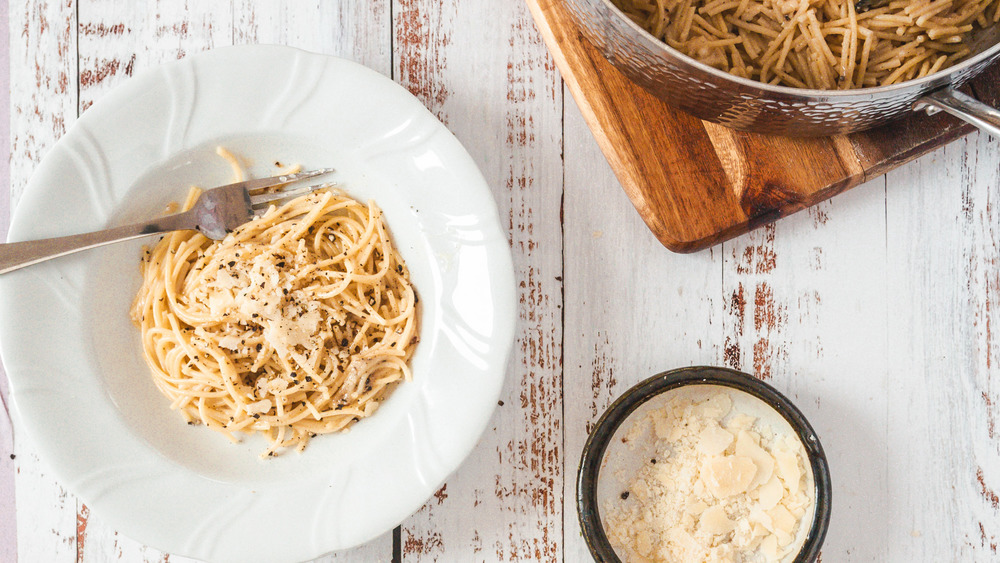
Ingredients
- 170 g spaghetti (6 oz)
- 4 tablespoons unsalted butter
- 2 teaspoons freshly ground black pepper, or more, to taste
- 1 cup Pecorino Romano, Parmesan or a mix of both
Directions
- Fill a large pot with water, and add salt. Bring to a boil. Add spaghetti and cook it according to package instructions, but subtract 2 minutes of the packaged cooking time (if the package indicates cooking for 7 minutes, cook for 5). Remove pot from stovetop and drain pasta, saving 1 cup of pasta water.
- Set a large skillet over medium heat. Add butter and melt. Add freshly cracked black pepper and mix well.
- Add half the reserved pasta water and bring to a simmer. Add pasta and stir well. Reduce heat to low and add half the cheese.
- Stir gently with tongs until pasta and cheese are combined well and cheese is fully melted into the sauce.
- Remove from heat. Add remaining cheese and stir to combine, until the sauce coats all the pasta strands.
- Serve immediately in bowls with additional cheese grated on top, and more cracked black pepper to taste.
Nutrition
| Calories per Serving | 816 |
| Total Fat | 43.6 g |
| Saturated Fat | 27.1 g |
| Trans Fat | 0.9 g |
| Cholesterol | 111.6 mg |
| Total Carbohydrates | 67.4 g |
| Dietary Fiber | 3.3 g |
| Total Sugars | 2.9 g |
| Sodium | 1,031.8 mg |
| Protein | 38.2 g |
